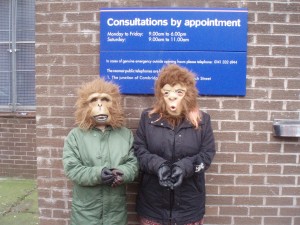May you enjoy some great jokes, pranks and laughs.
April Fools’ Day used to be just fun for me.
For the past 10 years—ever since my husband and I got married on April 1, 2003 outside at Yosemite National Park—the day now also evokes deep happiness.
(And appreciativeness too as I continue to be grateful to my husband for agreeing to get married on April 1. Many questioned if we would ever marry. So when we decided to wed after being together more than 10 years, April 1 seemed like an appropriate wedding date.)
As many of us know from history and life, the pursuit of happiness is more feasible than its daily practice. This is true for people and especially for organizations.
Then there is Zappos. The company’s brand promise is “delivering happiness to the world.” Considering the number of its satisfied, returning customers and its highly-engaged and productive employees, Zappos lives and breathes this promise.
While listening to Zappos CEO Tony Hsieh read his book Delivering Happiness: A Path to Profits, Passion, and Purpose on a recent road trip, I was pleasantly surprised to hear the section about the science of happiness. Even more impressive, Hsieh found time to read about this emerging area of the social sciences while trying to make Zappos a profitable, sustainable company. And even better, he and the Zappos team then started applying his new-found knowledge to the business.
Zappos is a textbook example of how business and customers can benefit from what science knows.
(As the best-selling author Dan Pink has written and demonstrated in his books, there’s usually a huge mismatch between what science knows and what business does.)
Luckily for Zappos customers and employees, Hsieh was a fast learner. He discovered and took to heart the research shows that people are very bad at predicting what will make them happy.
He refers to the studies on lottery winners that show their happiness levels didn’t increase over time. (I almost drove off the road in joy listening to this as I was one of the research assistants for Dr. Philip Brickman’s groundbreaking study, Lottery winners and accident victims: is happiness relative?)
Instead, rather than chase what you think will make you happy, it’s more productive to figure out what you can be a part of that has meaning to you. This is your big or higher purpose, which can provide the longest-lasting and deepest type of happiness.
From a business perspective, by expanding the Zappos vision to “delivering happiness to the world,” Hseih and his team provided a big purpose to ignite and unite employees. This big purpose also helps Zappos recruit candidates who share that drive as well as the company’s 10 core values.
Hseih didn’t stop there. He also incorporated into the work life at Zappos the three other key elements of happiness that matter on an individual level too.
Research has shown four elements that continually contribute to happiness, which are:
- Perceived control—Being in control of what and when you do helps you maintain a positive mindset.
- Perceived progress—You can be more satisfied making baby steps rather than one big leap if you notice and celebrate your incremental advancements.
- Connectedness—Being around people you enjoy can make you feel more engaged and be more productive, which is why it’s important to avoid energy vampires and to gravitate toward a strong company culture that resonates with you.
- Purpose—As stated earlier, being part of a vision or purpose bigger than yourself brings meaning into your life, which helps with happiness.
For more about the field of positive psychology, check out the wonderful website Authentic Happiness. Dr. Martin Seligman, who’s the Director of the Positive Psychology Center at the University of Pennsylvania and author of several books, shares some great resources as well as reviews his own work.
The website shows many examples of how positive emotions, strengths rather than weaknesses and healthy institutions help create a better environment for happiness.
Based on my training in the early happiness research as well as in David Rock’s NeuroLeadership coaching, which emphasizes a positive, brain-based approach, I wish more business leaders were embracing happiness like Hseih.
The recipe for happiness isn’t that hard if you put your mind to it and follow through. Take one big purpose and add well-designed and executed little things. You’ll make a huge difference.
For instance, as you implement your strategic initiatives, think about how you can give people more sense of control, help them feel progress and strengthen their connections to each other and your big purpose.
If you get stuck or want a partner in happiness, reach out to me. I’m committed to more happiness!
What about you? Are you ready for more happiness?


0 Comments